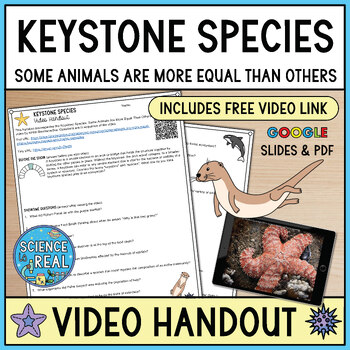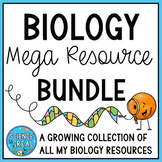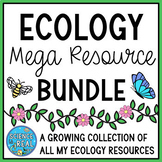Keystone Species Video Handout with Free Video Link
- PDF
What educators are saying
Also included in
- ⭐ ⭐ ⭐ ⭐ ⭐ Save Over 30% with this growing collection of biology resources! Get it now while it is still growing - it began with 50 resources and will build up to 400! If you purchase it now, you will get all products added in the future for FREE!⭐ Click on the preview to download more information abPrice $749.99Original Price $1079.09Save $329.10
- ⭐ ⭐ ⭐ ⭐ Save money and time with this Ecology Growing Bundle! Get this growing bundle now before more products are added and the price increases! These resources are designed for standard high school or advanced middle school science students. More resources will be soon added as I create new produPrice $234.99Original Price $336.48Save $101.49
Description
⭐ ⭐ ⭐ ⭐ This keystone species video handout accompanies an engaging and dynamic documentary about the interconnection between keystone species, trophic levels, and ecosystems. It includes questions (in sequence) to accompany HHMI Biointeractive’s 20 minute documentary titled Some Animals Are More Equal than Others: Keystone Species and Trophic Cascades.
The video is free and found on the hhmi Biointeractive’s website HERE or on YouTube HERE
This handout is perfect for an introduction or enrichment to the keystone species and ecosystems, a great sub-plan, enrichment, or lesson all in its own right. It’s perfect for Biology, Ecology, and Environmental Science classes.
The 20-question handout include a prior-knowledge hook question, 15 short answer questions that are timed in sequence to the video, and 5 summarizing analysis questions (including a CER style question!). The questions are formatted short-answer style, however no answer is much longer than 1-3 words. The questions are spaced out so that they do not go too fast or too slow and encompass the entire film from start to finish.
⭐ KEYSTONE SPECIES VIDEO TOPICS ⭐
- Keystone Species
- Biodiversity
- Trophic Levels
- Trophic Cascades
- Ecosystems
- Populations and Communities
- Predator and Prey Relationships
- Food Webs and Food Chains
- Human Impact
- Biodiversity
⭐ WHAT YOU WILL RECEIVE ⭐
- 2 Page PDF Version with link and QR code
- Google Slides Version with Pre-formatted Text Boxes and Video Link
- Answer Key (timestamped)
⭐ You may also like ...
• Food Chains, Food Webs, and Energy Pyramids Reading Comprehension Worksheets
• Biodiversity and Endangered Species Webquest
• A Plastic Ocean Worksheet Movie Questions and Answer Key
Video Description from HHMI Biointeractive -
“Keystone species and trophic cascades are fundamental concepts in ecology. This short film tells the story of how these concepts were first established through the pioneering experiments of two young researches: Robert Paine and James Estes. The short film opens with two questions: “What determines how many species live in a given place? Or how many individuals of the species can live somewhere?” The research that provided answers to these questions was set in motion by key experiments by ecologists Robert Paine and James Estes. Robert Paine’s starfish exclusion experiments on the coast of Washington state showed that removing starfish from this marine ecosystem has a big impact on the population sizes of other species, establishing the starfish as a keystone species. James Estes and colleague John Palmisano discovered that the kelp forest ecosystems of the North Pacific are regulated by the presence or absence of sea otters, which feed on sea urchins that consume kelp. These direct and indirect effects of sea otters on other species describe a trophic cascade. These early studies were the inspiration for hundreds of investigations on other keystone species and trophic cascades, as well as ongoing studies into the regulation of population sizes and species numbers.”
Film Awards
- 2016 Jackson Hole Science Media Awards: Finalist
Just Print and Go! Perfect Sub Plan!
⭐ Connect with Me!
❤️ CHECK OUT MORE GREAT THINGS FROM SCIENCE IS REAL! ❤️
⭐ HUMAN IMPACT AND THE ENVIRONMENT ⭐
• A Plastic Ocean Worksheet Movie Questions and Answer Key
• Human Impact On The Environment Webquest
• Climate Change CER, Reading Comprehension, and Graphing Lab
• Climate Change Stations Lab - Student-Led Climate Change Stations
• Biodiversity Reading Comprehension Worksheets
• Biodiversity and Endangered Species Webquest
• Biodiversity, Water Pollution, and Biomagnification Webquest
• Modeling Biomagnification and Bioaccumulation of Mercury Lab Activity
• Cookie Mining Lab - Natural Resources CER Edible Lab Activity
• Natural Selection in Peppered Moths Reading, Color, and Camouflage Activity
• Peppered Moth Natural Selection Webquest
⭐ ECOLOGY ⭐
• Ecology Bundle - Growing Ecology Resource Bundle
• Aquatic Ecosystems PowerPoint with Notes, Questions, and Kahoot
• Food Chains, Food Webs, and Energy Pyramids Reading Comprehension Worksheets
• Biodiversity Reading Comprehension Worksheets
• Biodiversity and Endangered Species Webquest
• Biodiversity, Water Pollution, and Biomagnification Webquest
• Cookie Mining Lab - Natural Resources CER Edible Lab Activity
• Modeling Biomagnification and Bioaccumulation of Mercury Lab Activity
• Carbon Cycle Game - Rotation Stations Game with Analysis and Assessment
• Ocean Zones Poster Project - Layers of the Ocean
• Biogeochemical Cycles Diagrams Worksheets Bundle
Science Is Real! Terms of Use (TOU):
By purchasing this product, you own a license for one teacher only for personal use in their own classroom. Licenses are non-transferable and therefore cannot be passed from one teacher to another. If the teacher who purchased this license leaves the classroom or changes schools, the license and materials leave with that teacher. No part of this resource is to be shared with colleagues or used by an entire team, grade level, school or district without purchasing the correct number of licenses. If you are a coach, principal or district interested in transferable licenses that would accommodate yearly staff changes, please contact me for a transferable license quote at ajcatts@gmail.com or scienceisrealeducation.com
Please note - all material included in this resource belongs to Ana Catts. By purchasing, you have a license to use the material, but you do not own the material. You may not upload any portion of this resource to the internet in any format, including school/personal websites or network drives unless the site is password protected and can only be accessed by students, not other teachers or anyone else on the internet.
Purchase of the product is for single classroom use by the purchaser only. It is a violation for individuals, schools, and districts to redistribute, edit, sell, or post this item on the public Internet or to other individuals. Disregarding the copyright is a violation of the Digital Millennium Copyright Act and subject to legal action.
- By purchasing this product you acknowledge that you have read and understood the Terms of Use.
- Dude Dots Clipart by the talented (C)Sarah Pecorino Illustrations
HAPPY SCIENCING!
⭐ Connect with Me!
❤️ CLICK TO FOLLOW SCIENCE IS REAL!
Get News of Sales, New Products, and Discounts!







